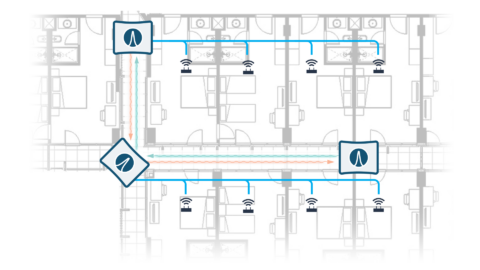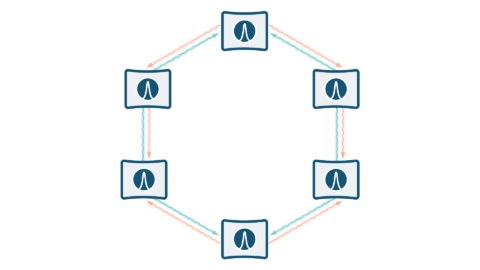People often ask why Airvine chose to develop an entirely new in-building networking solution when the well-entrenched legacy approach of using structured wiring already exists. Is a new solution really necessary? To answer this question and truly understand the shift, we need to consider the dynamic nature of the modern enterprise. This consideration leads us directly to the concept of rethinking in-building enterprise networking, an approach that addresses the rapidly evolving demands of today’s businesses.
Be it an MDU, a hotel, a large warehouse, a sports arena, or an office complex the age of stringing wire through the rafters and leaving it up there for 40 years has passed. These business entities are changing rapidly, and they need a network that is as agile, flexible, and adaptable as the business it supports. Nowhere is this more apparent than in the gamut of new applications. sweeping through the enterprise. The list here includes everything from augmented reality to the Internet of Things, and this is only the beginning. It’s time to rethink in-building enterprise networking.
Major changes are already emerging in access networks, with Ethernet losing its significance in most enterprises. This trend will only speed up as we adopt Wi-Fi 6E and eventually move to Wi-Fi 7. Wi-Fi 6E has much to offer, starting with the “E” that introduces 1.2 GHz of new spectrum available for Wi-Fi access points in the U.S. However, Wi-Fi 6E encompasses more than just spectrum; it delivers low latency, deterministic performance, throughput nearing 10 Gbps, enhanced roaming capabilities, increased capacity, and significantly improved security. It’s almost perfect!
Rethinking In-Building Enterprise Networking
Access technologies are making great strides, but we have not seen similar advances in the necessary backhaul systems. This disparity is set to change with Airvine’s launch of the WaveTunnel system. This system stands out as the most innovative piece of in-building network technology to emerge in decades. It is tailor-made for modern radio access networks, supporting technologies like Wi-Fi 6E and eventually private 5G small cells.
 WaveTunnel technology delivers a host of advantages that can be leveraged across just about every enterprise vertical and that list includes:
WaveTunnel technology delivers a host of advantages that can be leveraged across just about every enterprise vertical and that list includes:
- Supporting more than just computer connectivity requires that broadband services be activated anywhere in the enterprise within minutes. These services enable quick activation of any application, regardless of throughput, latency, or security concerns.
- IT – OT segmentation. Enterprises worldwide are rolling out OT networks, but for security reasons, they should always physically separate these from the more vulnerable IT networks. WaveTunnel facilitates this by providing a parallel but distinct network.
- Fast and easy moves, additions, and changes make the network as agile as the business it supports. You no longer have to wait weeks or months for network reconfiguration.
- No business disruptions during installs.
- Gigabit/sec data transfer rates.
- Easily installed in ANY kind of building.
- Very cost-effective when deployed in concert with technologies like Wi-Fi 6E.
So, how might WaveTunnel technology be deployed in the modern enterprise?
Here are a couple of examples showing how the convergence of WaveTunnel technology with broadband access technologies like Wi-Fi 6E enables a host of new applications, from IoT to AR/VR, to hit the network.
Versatile Ring-based Deployment
You could cover a 30,000-square-foot building with Wi-Fi 6E access points at each of ten different locations using Airvine technology for backhaul. Two wireless rings, each with five remote nodes, would handle the job. Each remote node connects to a Wi-Fi 6E access point at that location. The sixth WaveTunnel node would reside in the ‘unwiring’ closet, sending traffic to the enterprise backbone. The network carries traffic in both clockwise and counter-clockwise directions on the wireless ring, with each wireless hop limited to 100 meters. As business needs dictate changes to the access network, you can easily adjust the backhaul network. You can manage all changes on a DIY basis without needing wiring contractors.

What Makes This Approach So Compelling:
- Very cost-effective when compared to solutions that involve pulling of wire all over the building.
- Creates an extremely agile network that can easily adapt to changing business conditions.
- Very robust architecture that survives single points of failure.
- Simple to install and maintain.
Enterprise Networks in Buildings
You can also apply the above example to factories, warehouses, and large public venues (LPVs) that need to cover very large areas and operate on a 24/7 basis. In these environments, the access networks will still use Wi-Fi 6E technology but will now support both IT and OT networks. For security reasons, you should always physically separate IT traffic from OT traffic. Industrial areas are also where private 5G small cell technology gets deployed, usually for OT applications. You can easily backhaul these different radio access networks (up to three in some cases) using the WaveTunnel system. The deployment can include multiple wireless rings large enough to cover the biggest buildings. The 100-meter distance between hops allows these rings to be quite large, and the quick, easy installs are ideal for enterprises operating around the clock.
What Makes This Approach So Appealing:
- Can cover a very large area with a wireless ring.
- Can support private 5G small cells (future) as well as Wi-Fi 6E APs.
- Very robust network architecture that can easily survive a single point of failure.
- Changes can be made without disrupting the business, which will often run 24 by 7.
These two examples showcase the versatility of the Airvine approach, which embodies the principles of rethinking in-building enterprise networking. The wireless ring architecture has become very popular across various industries because it can build networks that cover both small and very large areas. It serves as the perfect solution for backhauling broadband wireless access networks securely, reliably, and flexibly. Various sectors, including hospitality, MDUs, and higher education, widely apply this approach.
Have more questions? Let us know!
Originally Posted on August 20, 2021 by Steve Hratko